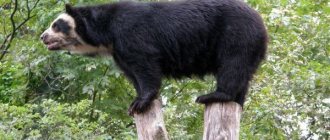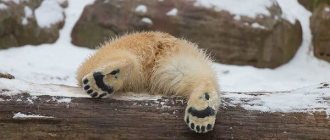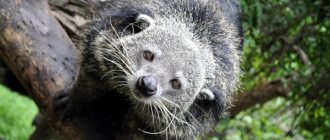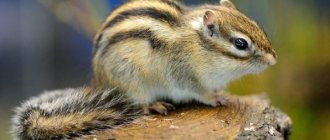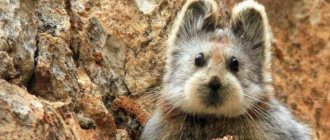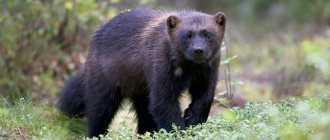The sloth bear originates from the bear family, but its appearance differs from the usual bear. And the behavior of the sloth fish is fundamentally different compared to its relatives. A low, thick body, small short legs, and an elongated muzzle - all this makes the sloth bear a distinctive species among bears. With its characteristics, the bear has been awarded a separate species – Melursus. And as the owner of long nails he received a second name - sloth bear.
The sloth fish can be found in the forests of Sri Lanka and Hindustan, in the meadow-covered areas of India, Bangladesh and Nepal. Slobbers spend the heat in specially dug gorges and hilly areas, usually between rocks or under large bushes.
Males sleep most of the day, and go out to hunt prey at sunset. However, female sloth whales are awake during the day, which is due to the high probability of attacks on their offspring by large predators.
Description and features of the sloth bear
Externally, the sponge bear looks more like an anteater or a sloth than a bear. The habits of the beast are also exotic. The sloth fish, for example, carries its offspring on its back. However, genetically the animal is related to clubfoot. From the behavioral habits of the hero of the article, rage is similar to them. About a thousand attacks have been recorded against people. Fifty cases resulted in death.
The sloth bear its name due to the structure of its muzzle. It is narrow and elongated. The animal's lips are slightly loose, as if protruding. The animal's nose is movable. All these are adaptations developed for the production of honey and fruit nectars. In order to reach them, the bear grew a long tongue. This is one of the similarities with the anteater.
The teeth of the sloth fish are small. The two upper incisors are missing. This makes it easier to insert your tongue into the honeycombs and date fruits. Newborn sponge fish have incisors, but they fall out with age.
The length of spongers reaches 180 centimeters. Saki often stretch only 1.5 meters. The height of females is 60-75 centimeters. Males reach 90 at the withers. Small sponge fish weigh 50 kilograms. Maximum weight - 130 kilos.
The sloth bear in the photo is distinguished not only by the structure of its muzzle, but also by its long paws with large feet, large ears, a white V-shaped mark on its chest and a light stripe on its nose. The hero of the article is also the longest-haired bear.
Family
At first, the male takes care of his family, which is not typical for other bears. The she-bear bears the cubs for six months, then 2-3 babies are born. The mother will go hunting with them as soon as the babies' eyes open. Mom often carries the bear on her shoulders. Even if the mother enters into battle with the enemy, the babies will not let go of the fur and will hold on tightly to her back. During the day, the mother bear and her cubs stay awake, fearing attacks from night predators. After 2-3 years, the cubs begin to live separately. In the wild, a sloth bear can live up to 25 years. In captivity - up to 40 years.
Interesting Facts:
- in captivity, so that the bear does not get too bored, he is offered to get food, for example, to find fruit in a pile of hay;
- At birth, a bear cub weighs less than a baby, its weight does not exceed 1 kilogram.
Lifestyle and habitat
A description of the sloth bear is not complete without an overview of the development of its sense organs. Of these, only the sense of smell is at its best. The animal's hearing and vision are poor to such an extent that the animal does not always notice an approaching person. At the same time, the bear smells him. This sparks anxiety. This is how zoologists explain the prevalence of sponger attacks on people.
Male sloth bears
You can meet the sloth fish in South Asia. This is the native region of the white-breasted bear. Outside of Asia, animals are found only in zoos. In Asia, the highest density of bear populations is recorded in India. Animals gravitate towards mountainous regions, choosing the ridges of the Himalayas. Hence the alternative name of the hero of the article - the Himalayan bear.
The sloth fish finds cultivated lands in the mountains, destroying human crops. Therefore, and because of cases of aggression by bears, they are shot. For the last decade, they have been doing this illegally, since the sponge fish is included in the International Red Book.
There are only 20 thousand individuals of Himalayan bears left. They are often saved by their nocturnal lifestyle. It’s difficult to meet the hero of the article during the day. During daylight hours, spongers sleep in secluded places. All of them are located in the tropics or subtropics.
Some females with cubs decide to switch to a diurnal lifestyle. When going out to look for food in the light, females protect their offspring from nocturnal predators. When the cubs grow up, the family returns to a nocturnal lifestyle.
Choosing hills for life, sloth fish do not strive to conquer Everest. The altitude comfortable for bears to live is limited to 3 thousand meters above sea level. Spongers are not found higher up or in the lowlands.
Where can residents of Russia see it in captivity?
Residents of Russia can see Gubachi at the Moscow Zoo. They live in the old territory next to the pandas. Zoo workers say that the bear sleeps during the day and leads an active lifestyle at night. He was given the interesting nickname Pelmen. At night Gubach snores.
At the zoo, the animal is fed minced meat and fish, various cereals, vegetables, cottage cheese, honey and eggs. The diet also includes fruits, insects, vitamin and mineral supplements. Some visitors are upset that the bear is constantly hiding behind bushes and a hammock.
Types of sloth bear
In addition to the Himalaya region, sloth whales live in Sri Lanka. They lack a light apron. Therefore, it is customary to classify island bears as a separate subspecies. Individuals in Sri Lanka are smaller than the Himalayan ones and have more sparse hair. There is no point in a thick fur coat, because the living conditions of the island species are warmer and softer.
Only scientific works have been written about island spongers. The Himalayan bear is also noted in fiction. Suffice it to recall the story of Mowgli, written by Rudyard Kipling.
Natural enemies of anteaters
Photo: Anteater
If in the wild conditions such large predators as pumas and jaguars act as enemies for giant and four-toed anteaters, then for dwarf representatives of the anteater family there are much more dangers; they can even be threatened by large birds and boa constrictors.
The large anteater's main weapon is its huge ten-centimeter claws, with which it can tear apart an enemy like sharp hook knives. During a fight, the animal stands on its hind legs and fights its enemy with its front legs; these strong limbs can even crush the enemy. Often, predators, seeing such courage and power, leave and do not contact the large anteater, because they consider it a dangerous and strong opponent, capable of inflicting serious wounds.
Tree baby anteaters also bravely defend themselves, despite their dwarf size. They also stand in a stance on their hind legs, and keep their front claws ready in front of them to strike the enemy. The four-toed anteater, along with the main defense mechanisms, also uses a special odorous secretion, which is secreted by its anal glands, scaring away enemies with an unpleasant odor.
Still, humans have the greatest impact on the number of anteaters, exterminating them both directly and through their active life activities.
Nutrition
Initially, many scientists classified the sloth fish as a member of the anteater family. This is due to the structure of the muzzle, tongue and food preferences. Most of all, Himalayan bears love ants and termites.
Spongers get prey from houses using not only their tongues, but also their claws. They are long and sharp, like knives cutting through anthills. This is how the predator gets to the home of the Hymenoptera.
Having cut into an anthill, the sponger blows dust out of its passages and licks off the prey. In one sitting, a bear is able to eat one large colony. Himalayan clubfoot diversify their protein menu with honey, berries and fruits. In Sri Lanka, for example, bears have taken a liking to date palms and hunt for their fruits.
Finding out interesting facts about the sloth bear , you will find out that it can even eat sugar cane and plant roots. However, these dishes are “stored” for a rainy day. If there is other food, the animal will prefer it. Due to hunger, spongers not only consume roots, but also destroy bird nests and attack other animals.
The longest muzzle with movable lips
Sloth bears received this name due to their elongated muzzle with bare, moving lips. The sloth fish is able to extend its lips beyond its jaw, imitating a trunk, allowing it to vacuum up insects from a colony of termites and ants. The process of eating food is quite noisy; it can be heard more than 150 meters away. An additional feature of spongers is the presence of 40 teeth without upper fangs, characteristic of carnivorous predators.
Reproduction and lifespan
The life of a sponge fish is limited to 20-40 years. It's in the wild. In captivity, animals live 5-10 years longer, but they have difficulty reproducing. In nature, Himalayan bears give birth once every 3-4 winters. They conceive cubs in April. Before giving birth, female bears retire to secluded places. Usually these are caves and dens covered with stones.
Female sloth bear with cubs
At the same time, the female sloth whale gives birth to from 1 to 3 cubs. Often there are 2 of them. Animals are born completely blind and deaf. For the first 2 months, the mother takes care of the offspring in the den, after which she begins to carry them on her back to the outside world. By this time, the cubs' eyes open and their hearing improves.
The cubs remain with their mother until puberty. It occurs in the 3rd year of life. Then the female prepares for the next birth under favorable environmental conditions, or spends a year recovering and gaining weight.
Sponge fish are born weighing 400 grams. This gives an idea of the vulnerability of babies. They remain milk-fed for up to 1.5-2 years, although they begin to diversify their diet at another 3-4 months.
This is the time for active games. The bears are still not careful enough. The bear is watching to see if a leopard or a Bengal tiger is approaching. Apart from large cats, no one dares to hunt Himalayan clubfoot.
Sloth in the Red Book
In 2022, the species was listed in the Red Book as vulnerable. The bear is extremely rare in zoological collections. It is also part of the Convention on International Trade in Endangered Species of Wild Fauna and Flora.
Main causes of extinction
Previously, Gubachs were exterminated due to their wrecking of plantations where dates, sugar cane, date palms and corn grew. Animal apiaries were destroyed.
The skin is not particularly valuable today. Animal meat is not eaten. In Asia, doctors use Gubach's gall bladder as a medicine.
The main reasons for the extinction of the species remain the destruction of termite mounds and deforestation.
Current population situation
The number of animals is about 10 thousand individuals. According to some sources, there are 20 thousand individuals left.
The number of animals continues to decrease despite the fact that trade and extermination of bears is prohibited. A serious danger is posed by deforestation, destruction of termite nests, and reduction of the food supply.
What measures were taken to protect
Animals are on the verge of extinction due to the fact that humans occupy their territory. Sloths simply have nowhere to live and no way to find food. Experts all over the world are striving to improve the conditions of clubfoot and are introducing new projects to protect forests.
The bears have protected status, so they are rarely seen in city zoos. Let them live better in freedom.
Winter dream.
Some species of bears, especially those that live in areas with harsh winters, spend the coldest part of the year in a deep sleep in a den. Pregnant females give birth to cubs there, but males and non-pregnant females may not stop activity at all in winter, remaining “connecting rods”.
Bears' winter sleep is not real hibernation, since metabolic processes in the body do not slow down, and the animal is easy to wake up. For example, the American ground squirrel Spermophilus parryii goes into real hibernation. In the active state, its body temperature is close to 38 ° C, and during wintering it drops to almost 0 ° C. In a black bear that has fallen into winter sleep, the body temperature, which is approximately 38 ° C in summer, drops to 34–31 ° C.
Evolution.
In the order of carnivores, bears are the youngest group, separated from ancient wolves in the late Miocene, ca. 10 million years ago or a little earlier. The first bears were similar to wolves in many ways.
The modern genus Ursus, known since the late Pliocene in Europe and Asia (about 3 million years ago), reached North America shortly thereafter. Its first representatives were small, the size of a modern Malayan bear, but in the Pleistocene era giant species also appeared. The largest of them, the cave bear (U. spalaeus), who lived in Europe, rivaled the Alaskan brown bear in size; it was almost as good as the first brown bears (U. arctos), which appeared in China ca. 400,000 years ago.
Remains of hundreds of thousands of cave bears have been found in Europe. The most amazing discovery was made in the Dragon Caves in Austria: the bones of approximately 30,000 of these animals were discovered here. Many of the bones belong to immature, sick or old individuals that died here during hibernation for centuries. Perhaps the reason for this was the weakening of the body in the previous summer due to illness, old age or lack of food.
The European cave bear became extinct approximately 12,000 years ago. Although people hunted it, it is unlikely that this is what led to the extinction of the species. Perhaps the decisive factor here was competition with the brown bear.
Dimensions.
Also on topic:
SYSTEMATICS OF ANIMALS
The smallest bear is the Malayan (Helarctos malayanus), and the largest is the Alaskan brown (U. a. middendorffi) and white (U. maritimus). The total length of the first type can be approx. 1 m with a height at the withers of less than 68 cm (when the animal stands on four legs) and a weight of approx. 27 kg. The Alaskan brown bear is the largest land predator. Its length reaches 2.25 m (according to unconfirmed data - 2.8 m), height at the withers 1.3 m, and weight 770 kg. Standing on its hind legs, it can reach objects located at a height of 4.5 m. Polar bears can be up to 2.5 m long, with a height at the withers of up to 1.6 m and a weight of more than 770 kg.
Taxonomy.
Also on topic:
MAMMALS
The bear family is part of the order Carnivora and is divided into 4 subfamilies, one of which, Agriotheriinae, unites species that became extinct in the Pleistocene. The panda subfamily (Ailuropodinae), which includes the giant panda (bamboo bear) of China, has long been controversial among taxonomists, with some placing it in the raccoon family (Procyonidae) and others considering it a distinct family, Ailuropodidae. However, a more detailed study of anatomical features, as well as paleontological and molecular analysis data, made it possible to classify the giant panda as a bear. See also PANDAS.
In this volume, the family consists of five modern genera and eight species. The only species of the subfamily Tremarctinae lives in South America; the subfamily Ursinae with 3 genera and 6 species is distributed in North America, Asia and Europe. There are currently no bears in Africa, although representatives of the extinct subfamily Agriotheriinae once lived in the south of this continent, and one of the subspecies of the brown bear, Ursus arctos crowtheri, was found in the Atlas mountain range in Morocco and Algeria until the beginning of the 19th century. was completely exterminated.
How do they look?
The Himalayan bear is unusual in appearance and absolutely charming. These bears are half the size of the brown forest owners we are used to. Despite their rather miniature dimensions, these bears are distinguished by their rounded shapes. They look like good-natured furry bumpkins. It’s not for nothing that the Chinese compare them to dumplings.
The muzzle of these bears constantly changes its expression; the animals demonstrate emotions almost like a person. This feature is due to their sharp nose and large round ears that stick out diagonally from the corners of their eyes. If you connect the tip of the nose, the corners of the eyes and the ears with lines, you will get a neat high triangle.
How are they useful to humans?
In addition to zoos, Himalayans live on bear farms. They are not only kept there, but also bred. The main purpose of breeding is the extraction of bear bile. This is an extract extracted from the gallbladder of an animal. Its main chemical component is ursodeoxycholic acid. Bear bile is the main ingredient in many traditional medicines.
Unfortunately, even the humane modern method of collecting it (without killing the animal) affects the health of the bear and its life expectancy. Farm inhabitants live no more than 5 years.
There are bear farms not only in Russia, but also in other countries:
- China;
- Burma;
- North and South Korea;
- Laos;
- Vietnam.
Many public organizations oppose cruelty to animals on bear farms. However, bear farms are the main suppliers of medicinal raw materials in Asia and the East. Bear bile is used not only in folk medicine, but also in pharmaceutical plants.

